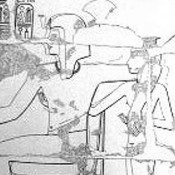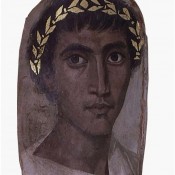So you’ve gone through all the trouble of mummifying a loved one. You’ve hired embalmers to remove the organs, treat the body with a precise mixture of oils and balms, and carefully wrap it in bandages. You’ve spared no expense on a lavish tomb, beautifully decorated and stuffed with riches. You’ve even mummified their pets, all to make sure they will fully enjoy their afterlife. There’s just one last question: What is your beloved mummy going to eat for the rest of eternity?
For some ancient Egyptians, the answer included meat. In King Tutankhamun’s tomb, for example, archaeologists found 48 wooden cases of butchered cuts of beef and poultry. But unlike offerings of fruit and grains, which could last for quite a while once dehydrated and placed in dry tombs, pieces of meat required special treatment. After just a few hours in the desert heat, “they will become a terrible mess if you don’t take some steps to preserve them,” says Richard Evershed, an archaeological chemist at the University of Bristol in the United Kingdom. The solution? Mummify.
Now, a team of researchers led by Evershed is shedding light on the embalming processes used to create these so-called meat mummies.
In order to find out which chemicals were used to mummify meat, Evershed and his team used mass spectroscopy to analyze samples of the bandages taken from four meat mummies housed in Egypt’s Cairo Museum and the British Museum in London. For some of the meat mummies, such as a calf that had been prepared as food and placed in a tomb dated between 1070 and 945 B.C.E. and a goat leg mummified around 1290 B.C.E., the only preservative was some type of animal fat smeared over the bandages.
However, mummified beef ribs from an earlier tomb tell a more elaborate story. Such a mummidied rib which was to feed the life force (Ka) of Thuyu and Yuyia -the parents of Queen Tiy (Pharaoh Amenhotep III’s wife)- was treated with a resin from a plant belonging to the genus Pistacia, the researchers report online today in the Proceedings of the National Academy of Sciences. Pistacia resins were very expensive, imported from the Mediterranean and used by elites as incense, varnish, and—perhaps significantly—food flavoring. They have also occasionally shown up as a preservative used on human mummies. But at this point, the earliest known use of Pistacia resins in human mummification happened at least 600 years after this luxury beef rib mummy was prepared. If Pistacia was indeed used to preserve the ribs at this early date, rather than just to flavor them, it suggests that “mummification may have been more sophisticated in these early times than we originally thought,” Evershed says. Still, he is wary of drawing any definitive conclusions until more human, animal, and meat mummies from high-status burials can be studied.
Stephen Buckley, an analytical chemist of the University of York in the United Kingdom, agrees. When it comes to ancient Egyptian mummification, it’s hard to tell which practices were common when and how they may have changed over time. For example, Buckley suggests that around the time the beef rib mummy was made (between 1386 and 1349 B.C.), Pistacia resin was actually used in mummification much more frequently than Evershed’s team assumes. His theory is presented in his so far unpublished work.
In any case, what about the taste? Unfortunately, even the best mummification techniques have their limits. “From the encounters I’ve had with mummies, they smell pretty disgusting,” Evershed says. “I think you’d be extremely unwise to try to eat them.”




